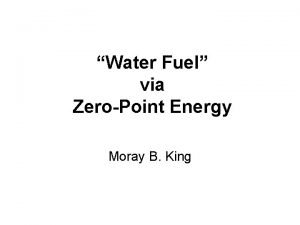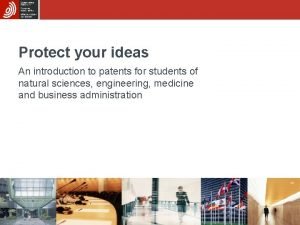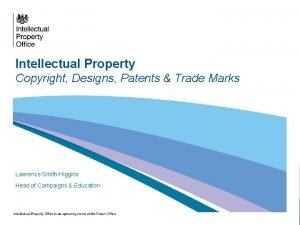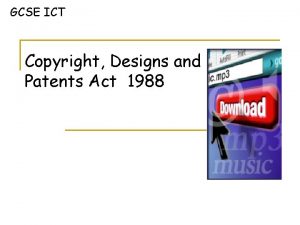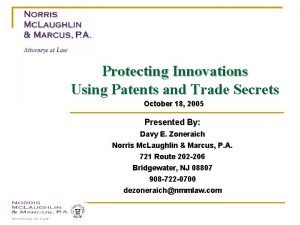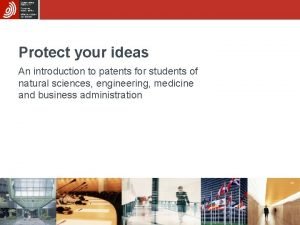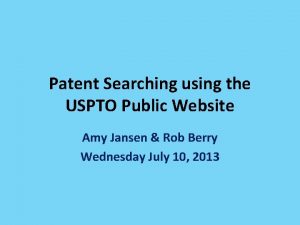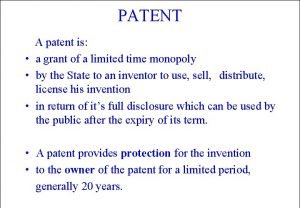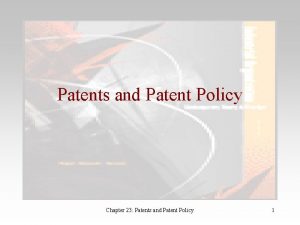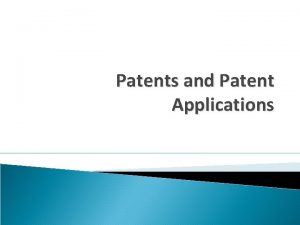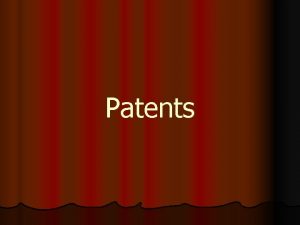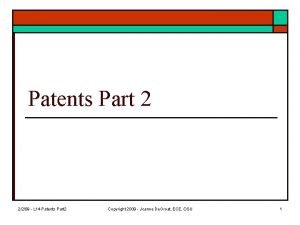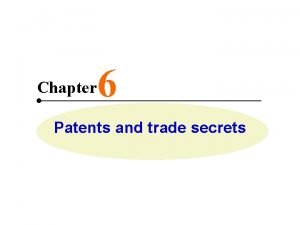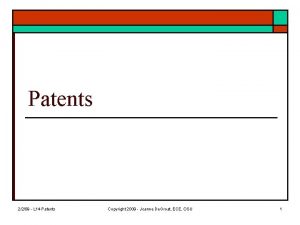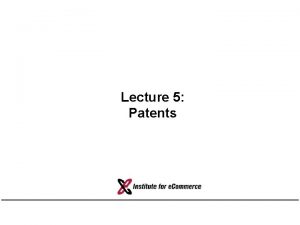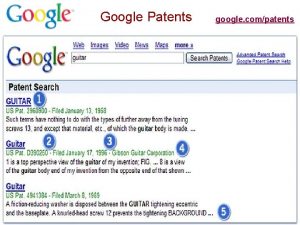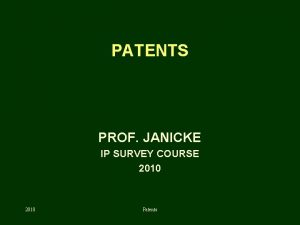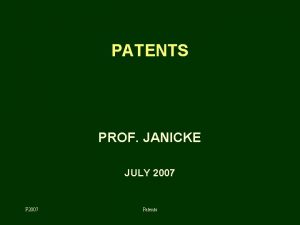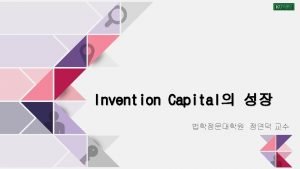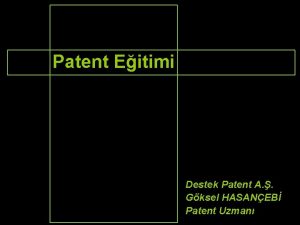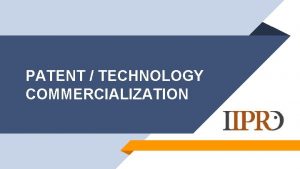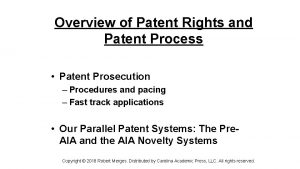Patent The Patent Class This American Life Patents




















- Slides: 20

Patent

The Patent Class

This American Life • Patents makes it safe to share your ideas • 2004 -2009, +70% patent lawsuits and +650% license requests • “Patent Troll” – Hoarding IP, make no products, look to sue • Lawsuits slow innovation; raise costs • Re$ource based activity; those who can pay can play • Software patents used to be copyrightable only

Leadbeater • Market created by consumers; companies follow • Disruptive inventions and radical innovations come from outside the industry

Leadbeater Cont'd • Bottom up creativity vs. Top down – Producers consumers' ideas • Innovations are collaborative, develop slowly • Payoff for innovation is greatest when uncertainty is greatest – Consumers help dictate the uses of an invention (invent the USE); uses of invention worked out through use – New ideas are disruptive and don't happen within large organizations. . . corporations follow. Emerging markets are creative

Patent Basics • 35 U. S. C. (from Constitution) protect ideas applied to inventions, NOT just ideas themselves • Receive limited monopoly of 15 -20 years, in exchange for making idea “public domain” • While idea is public domain, to use it a LICENSE must be obtained from patent holder (license=$/permission) • By applying, the idea is made known to the public

Patent Basics Cont'd EXCLUSIONARY right granted to natural people (inventors), assigned or licensed to corporations • NO corporate authorship!!! • NO FAIR USE!!! • Employees usually must assign patent to corporations when made under employment • Limited property right, shared w/ public 15 year (design patents) and 20 -year durations – Extendable for patents that must go through

Filing • $$$$$ and knowledge for application • Patent examiner (lawyer) at USTPO • 20 rejections for every allowance • Unless inventor has capital/knowledge, must partner w/ corporation or sell • “Patent Pending”= a warning that patent application filed; protect against injunction, etc.

Filing Cont'd • Costs $5000 -$20, 000 in U. S. ; $100 k + for PCT • The patent application filing fee for a basic utility patent is $330, which is in addition to a $540 utility patent search fee and a $220 examination fee, plus patent maintenance fees of $980 after three years • Provisional (12 month to protect idea) vs. Non -provisional (a full patent) • 97% of patents make less money than cost to obtain


First to File v. First to Invent • Steps of Invention in US – 1) conception – 2) reduction to practice (filing patent and uses) • America Invents Act of 2011 – US a first to invent to a first to file system – Went into effect March 16, 2013 • US was only FTI, rest of the world was first to file (FTF).

Edison Phonograph • 5 main parts, based on prior art: – 1) the trumpet, sketched by da Vinci and used in communication systems for the Duke of Milan – 2) the diaphragm, articulated by Hippocrates of Greece and used in drums – 3) the stylus, used in pictographs by Egyptians and Assyrians – 4) moving cylinders, used in lathes – 5) the feed screw, an innovation of

What Does Patent Protect • Plant patents: asexually reproduced plants (non seed; rooting, budding, grafting, etc) • Design patents: ornamental design; NOT function • Utility patents: “patents for invention”; 90% of patents are these • Improvement patent: if technology underlying the improvement is still patented, new inventor cannot exercise the improvement w/out license, cross license or “license pool”

But not. . . • Cannot patent products of nature (a tree or water) or laws of nature (fruit rots, gravity) • Cannot patent mathematical theory, just how it's applied in inventions • Cannot patent abstract ideas (like math) • BUT, medical procedures and living organisms are PATENTABLE • After 2013, cannot patent DNA (20% of human genes had been patented)

Utility Patent • Invention of a new and useful process, machine, manufacture, or composition of matter, or a new and useful improvement thereof • Functionality of item – Machine: moving parts – *Article of manufacture: solid (smart phone, hammer, ceramics, chairs) – Composition of matter: chemical compound – Method/Process: means to an end (software)

Design Patent • Ornamental design on utilitarian objects (*articles of manufacture) – Beverage containers, jewelry, furniture, computer/phone icons, novel fonts, building • Similar to “trade dress” but trade dress assumes “secondary meaning” • Duration of 15 years (formerly 14 pre-2015) • Applies to design, NOT function – Can be invalidated if design has practical utility


Patentability Requirements • Novel: the same invention was not made by someone else • Non-obviousness: can't be just a combination of prior works; most challenging hurdle and core requirement of patentability • – Must be an “inventive leap” – Mt. bike would not be patentable Utility: if it works, it has utility – “useful Arts” from Constitution

2013 Supreme Court Decisions • Assoc. for Molecular Pathology v. Myriad Genetics – Can "products of nature" be treated the same as "human-made" inventions? – Court says NO, but scientist made DNA and processes still patentable (c. DNA=complementary) Bowman v. Monsanto Company • – Can you save seeds from patented seeds? – Farmer claim patented exhaustion (like “first sale”) – NO, infringes on patents. Buy seeds=license for underlying patent

Patent Absurdity • Patent and the Remix? – Use “prior art”: any technology has other technologies and patented ideas in it – Mix elements together to make something new • Patent about how something works, no what it does per se • If no patent, why innovate? • These technologies also allow us to infringe (i. e. computer/software). . . ironic? • The problem of software patents?
 Quantum foam
Quantum foam Advantage of patent
Advantage of patent What is the copyright designs and patents act 1988
What is the copyright designs and patents act 1988 What is the copyright designs and patents act 1988
What is the copyright designs and patents act 1988 Types of patents
Types of patents Advantages and disadvantages of patents
Advantages and disadvantages of patents Uspto
Uspto Patents are granted for a new
Patents are granted for a new Patents
Patents Hát kết hợp bộ gõ cơ thể
Hát kết hợp bộ gõ cơ thể Slidetodoc
Slidetodoc Bổ thể
Bổ thể Tỉ lệ cơ thể trẻ em
Tỉ lệ cơ thể trẻ em Voi kéo gỗ như thế nào
Voi kéo gỗ như thế nào Thang điểm glasgow
Thang điểm glasgow Bài hát chúa yêu trần thế alleluia
Bài hát chúa yêu trần thế alleluia Kể tên các môn thể thao
Kể tên các môn thể thao Thế nào là hệ số cao nhất
Thế nào là hệ số cao nhất Các châu lục và đại dương trên thế giới
Các châu lục và đại dương trên thế giới Công thức tiính động năng
Công thức tiính động năng Trời xanh đây là của chúng ta thể thơ
Trời xanh đây là của chúng ta thể thơ
